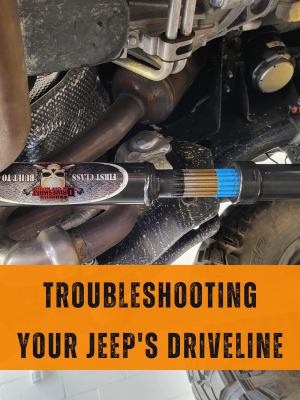
Troubleshooting Your Jeep's Driveline and Driveshaft
Jeeps are synonymous with ruggedness and off-road capability, but even the sturdiest vehicles face their share of mechanical woes, especially when it comes to the driveshaft. These components are vital for transmitting power from the engine to the wheels, enabling your Jeep to tackle everything from steep inclines to rocky terrains. However, the harsh conditions encountered off-road can expedite wear and tear, leading to issues that can affect performance and even cause breakdowns. This article provides a detailed walkthrough for troubleshooting common problems with your Jeep's driveshaft, ensuring you can quickly get back to conquering the great outdoors.

Understanding the Symptoms
Vibrations: One of the first signs of a driveshaft issue is unusual vibrations coming from underneath the vehicle. These can range from a slight tremor to a significant shake, especially at higher speeds. Vibrations typically indicate a problem with the driveshaft's balance or a worn U-joint.
Unusual Noises: Listen for noises such as clunking, squeaking, or grinding. A clunking noise when accelerating or decelerating usually points to worn U-joints or a failing driveshaft CV joint. Squeaking at low speeds may suggest that the U-joints need lubrication.
Step-by-Step Troubleshooting
-
Visual Inspection: Begin with a thorough inspection of the driveshaft and related components. Look for visible signs of wear or damage, such as rust, cracks, or any components that appear loose or out of place.
-
Check the U-Joints: The U-joints connect various sections of the driveshaft and allow for flexibility. Check these joints for any play or movement by hand. Any noticeable looseness could be the source of your problems. Also, look for signs of rust or corrosion, which could indicate a lack of lubrication.
-
Inspect the CV Joints: If your Jeep is equipped with CV joints, inspect them for leaks, tears, or other damage to the boot. Grease leaking from the boot can attract dirt, leading to premature wear.
-
Evaluate the Driveshaft Balance: A driveshaft that's out of balance can cause significant vibrations. This usually requires a professional's eye, as it involves checking for missing balance weights and possibly rebalancing the shaft.
-
Assess the Differential: The differential plays a crucial role in allowing your wheels to turn at different speeds. Listen for any unusual noises coming from the differential, and check the fluid level and condition. Metal particles in the fluid can indicate internal wear.
-
Lubrication: Proper lubrication is vital for the driveline components. Ensure that all U-joints, CV joints, and other moving parts are adequately lubricated according to the manufacturer's recommendations.

When to Seek Professional Help
While many driveline and driveshaft issues can be identified through careful inspection and basic maintenance, some problems require the expertise of a professional. Contact Adams Driveshaft today.


